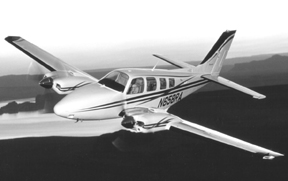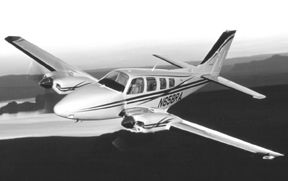
-by Jon Doolittle
If its true that getting old isn’t for sissies, buying aircraft insurance past age 65 occasionally requires the constitution of an ox and the kind of patience that, fortunately comes with age. Thats not to say older pilots cant find insurance. but underwriters don’t like to talk about this subject.
We can understand why. The entire pilot population is aging and as airplanes and flying become more expensive, there are fewer new young pilots. Flying is fast becoming a rich mans game and like it or not, the people that can afford it are often older.
Sixty seems to be the magic number. Right or wrong, its the age when airlines retire their pilots and the point at which insurers start examining applications more carefully.
A number of years ago, we examined the difficulties older pilots faced when buying aircraft. At the time, rates were low and more important, insurers were aggressively looking for new business. As we noted then, many underwriting managers were approaching middle age and beyond themselves and it seemed that pilot age was becoming less of an issue. Things have changed. And not for the better.
Age and Accidents
There’s no reliable literature that we know of tying age to increased likelihood of sudden incapacitation in the cockpit. Indeed, the reverse seems to be true. (See the sidebar at left.) If the insurance companies have convincing actuarial data on this topic, theyre keeping it to themselves.
At the same time, its a fact that many people lose mental acuity as they get older. Some lose memory functions, while others lose their reflexes or sensory functions gradually, such as sight and hearing.
Many of us have been through the experience of wishing that an older relative would stop driving an automobile. But people age differently. Some of us get to keep our wits longer than others.
For an aviation underwriter looking at an application for insurance from an older pilot, its impossible to judge whether hes a fit pilot or not.
In the past, a broker who knew his client could speak with an underwriter and make his case. Often he still can, but the remoteness of the underwriting process is making it less personal and less susceptible to subtle arm twisting.
The new model for aviation insurers is to have a central division for light aircraft, while the traditional branch offices continue to handle corporate aircraft and fixed base operators. For their light airplane customers, more and more companies are converting to computerized rating systems in an effort to deliver their products at an affordable cost.
The close relationship between the underwriter and the broker is becoming more distant. In addition, brokerages are growing and consolidating. In some cases, brokerages have become so large that they no longer know their customers as we’ll as they once did.
Touchy Subject
We spoke to all of the major carriers about their policies regarding older pilots. Much like the last time we tried this, the subject seemed to be extremely sensitive. One underwriter refused to comment at all, even off the record.
Among those who did, the party line went something like this: We do not have a maximum age, we review each submission on a case-by-case basis, we insure numerous pilots who are in their 80s and still flying. Within that sweeping statement, however, there were two slightly different variations.
One underwriter told us that her company has a provisional cut-off age for new applicants, but would not say exactly what that age was. The underwriter said that this was not a hard and fast rule, but more of a guideline.
In cases where the company agreed to insure pilots over this age, it might offer lower limits of liability coverage than it would to a younger pilot with similar experience. The company would not reduce coverage for clients beyond that age who were already insured with the company, but it might require annual medicals.
Another company told us that they don’t have a stated cut-off age but look instead at flight experience and at the type of airplane. This underwriter said that his company will usually require a higher class and frequency of medical exams than the FAA for older pilots, although like everyone else we talked to, he wouldnt say what he meant by older.
He also told us that his company sometimes reduced limits of liability as its insured pilots grew older. He views the problem of underwriting older pilots this way: Its a law of nature: People get older, reaction times increase, overall health decreases. We don’t have any way to know who is still sharp and who is not. Most of the other insurers that talked to us fell into one of these two groups.
Downhill at 65?
Just what is the magic age? We think that for most carriers, age starts to become an issue when a pilot reaches 65. This is more from our own experience and from speaking with other brokers than from company sources. No underwriters would be drawn into answering this question, although we know they know the answer.
Almost all of the companies that we spoke with told us that they treated their existing customers more favorably than new customers.
Insurers told us unanimously that they would not refuse to offer renewal to a client solely due to his age and this seems to be true from our own experience. Two companies said that they would not reduce limits of liability as long as a client renewed with them.
Our sense of the market is that a pilots age is one more variable to underwriters, like flight time, runway length and training. The difficulty is that the effects of aging on a specific pilot are an unknown. This is the hard truth behind the issue, which is supercharged by federal anti-discrimination laws.
We all know 70-year- old pilots who are still at top of their games, just as we know others whose age really has begun to erode their skills.
The underwriter sitting at his computer in an office building cant tell one from the other. Its also a variable that he cant talk about to a degree that surprised us. Yes, the insurers want your business. But they refuse to be specific about issues involving older pilots.
When making a decision about an older pilot, underwriters generally look at more than age alone. The basic question is always the match of the pilots experience and skills with the airplane he or she is flying.
Underwriters are also interested in whether the pilot is flying actively and perhaps receiving some sort of training each year or improving his flying knowledge by adding ratings or upgrading certificates. Another variable in this equation is the type and value of the airplane.
The owner of a $50,000 Cessna 172 or Piper Warrior who carries liability coverage of $1 million or less will get more quotes than the owner of a light twin worth ten times as much or an airplane carrying a much larger limit. This is even more true for older pilots.
The physiological effects of aging on pilots have not changed in the time since we last asked these same questions. What has changed is the willingness of carriers to take on the unknown. While premiums for most light singles have not increased drastically, underwriting guidelines are tight. A carrier that previously relaxed its own requirement for pilots of a certain age to receive an annual 2nd class physical will certainly require it now.
A carrier that has for years had a provisional cut-off age of 65 years is much less likely to waive it now than they would have been several years ago. Companies that usually relaxed requirements for annual simulator training are unlikely to do so now.
If youre the owner of a single-engine piston-powered airplane and carry fairly modest limits of liability, insurance will probably not be hard to find nor will it be ridiculously expensive, even if you are in your late 60s or early 70s, especially if you have substantial experience. You may find that there are fewer competitive quotes available to you and that you have to get a medical every year.
Pricey Step Ups
If you are transitioning into a more complex airplane, the process may be more difficult. When the insurance markets are tight, any type of transition gets more scrutiny for an underwriter. If youre much over the age of 65, you may find it even more challenging. This isn’t to say it cant be done, but you may have to change carriers to do it.
You may also have to be willing to live with a lower limit of liability, at least initially. And you can almost be guaranteed of a fairly high premium. While we were unable to find evidence that companies overtly charged their older insureds more money, its often true that without a competitive quote for leverage, theyre unlikely to reduce their prices.
We also think that they will sometimes say no to a transition that they might have agreed to for a younger pilot with equivalent experience.
While we could not quantify this and while this is a business defined by exceptions, we feel that insurers look at age as a greater problem in more complex aircraft like twins and turbines than they do in simple singles. Thats perfectly logical.
The other issue is that there are fewer underwriters willing to offer quotes for these airplanes to begin with. Where there’s less competition, prices will be higher. As always, the more experience you have, the less of a problem this is likely to be.
Not So Bad
Despite all of this unquantifiable doom and gloom, our prognosis for the general aviation insurance market is generally good. We feel that when the market softens, as it inevitably will, underwriting guidelines will all soften with it somewhat.
We also think that insurers will, within the next 10 years, be forced to face the fact that pilots are aging, or theyll have no clients. We believe that they may need to devise better ways to determine the fitness of older pilots, especially in turbine equipment.
The next 10 years will see enormous growth in light jets and many owners who are signed up to buy these airplanes will be in their 60s or 70s by the time theyre delivered.
If youre getting to be an old pilot and youre keeping the airplane you have for the time being, we think that your best bet is to stay with your current carrier. In the long run, you’ll be better off, even if the premium is slightly higher. Youre much less likely to find that your company wont offer you renewal because youve hit some magic but secret age, or that your premium will drastically increase every year.
Its also more likely that you can keep the limit of liability that you have now. Be prepared for more frequent physicals and perhaps more training. If you plan to change airplanes in the next few years, contact your provider for advice before moving UP.
Watch the Step Ups
Its not inconceivable that insurance-or lack thereof-could be a deal breaker on the step-up purchase. There’s no magic bullet, but if you have done some homework, you’ll at least be aware of the obstacles.
Whether youre keeping what you have now or considering a move up, there are some things you can do to improve the way that you look to underwriters.
First and foremost, underwriters like their clients to be current and proficient. The more you fly, the better. Another step you can take is to undergo regular training. A phase of the FAAs Wings program is recognized by a number of companies.
If you have thought of upgrading your pilot certificate from private to commercial or adding a rating, this would be a good time to do it. Passing a written and a practical test are excellent signals to an underwriter that you are still fit to fly.
We think that if you use a good aviation specialist for a broker and an insurer with a good reputation, you’ll make out best. If youre concerned that your age may be beginning to be a factor, talk to your agent about a plan for the next several years.
Ask about which companies will continue to offer you the coverage you need while maintaining reasonable rates.
Also With This Article
Click here to view “Airline Pilots: Older Not Bolder.”
Click here to view “Checklist.”
Jon Doolittle owns Sutton James Insurance in Hartford, Connecticut. Hes an Aviation Consumer contributing editor. He is of indeterminate age but appears timeless to us.





